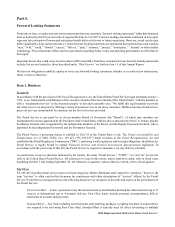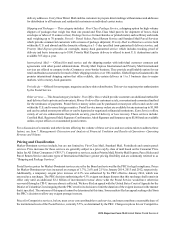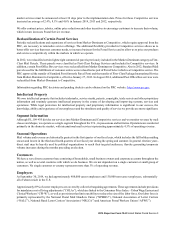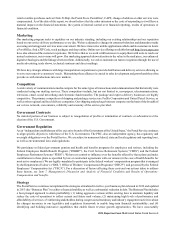US Postal Service 2014 Annual Report Download - page 14
Download and view the complete annual report
Please find page 14 of the 2014 US Postal Service annual report below. You can navigate through the pages in the report by either clicking on the pages listed below, or by using the keyword search tool below to find specific information within the annual report.
2014 Report on Form 10-K United States Postal Service 10
transportation fleet could inhibit our ability to be competitive in the marketplace, deliver a high-quality service and meet the
needs of the American public. The changes in the economic landscape in recent years have made it increasingly important for us
to invest in our operations in order to remain competitive. Failure to anticipate or react to our competition, market demands
and/or new technology due to inadequate cash reserves is a significant operational risk. An aging or potentially obsolete
infrastructure could result in a loss of business and increased costs.
We have a substantial amount of indebtedness.
Since 2012, our debt obligations have remained at the statutory $15 billion debt limit. Over the last two years, our cash balances
have ranged from $506 million to $5.4 billion. Our significant indebtedness to the Federal Financing Bank (“FFB”) has
important consequences. For example, it limits our flexibility in planning for, or reacting to, changes in the business
environment or competition; it places us at a competitive disadvantage compared to commercial competitors that may have less
debt and which have access to public capital markets; and it could require us to dedicate a substantial portion of our cash flow
from operations to payments on indebtedness, thus reducing the availability of cash flow to fund working capital, capital
expenditures and other general organizational activities.
Health and pension benefit costs represent a significant expense to us.
With approximately 488,000 career employees and approximately 490,000 annuitants and survivors participating in the FEHBP
as of September 30, 2014, our expenses relating to employee and retiree health and pension benefits are significant. We
participate in Federal Government pension and health and benefits programs for employees and retirees, including the FEHBP,
the CSRS and the FERS, as required by law. We have no control or influence over the benefits offered by these plans and make
contributions to these plans as specified by law or contractual agreements with our unions (in the case of health benefits for
most active employees). Several factors including participant mortality rates, return on investment and inflation could require us
to make significantly higher future contributions to these plans; and many of these factors are beyond our control.
In recent years, we have experienced significant increases in retiree health benefits costs, primarily as a result of P.L. 109-435,
which obligates us to fully fund, on an accelerated time frame, the health benefits of current retirees and current Postal Service
employees who have not yet retired. Additionally, we are required to continue contributing to the FERS pension program at the
Office of Personnel Management (“OPM”) specified rates and will likely be required to resume contributions to the CSRS,
beginning in 2017, if OPM determines that a supplemental unfunded liability payment is necessary.
Workers’ compensation insurance and claims expenses could have a material adverse effect on our business, financial
condition and results of operations.
Workers’ compensation expense accruals are established for estimates of the cash outlays that we will ultimately incur on
reported claims, as well as estimates of the costs of claims that have been incurred but not yet reported. Trends in actual
experience and management judgments about the present and expected levels of cost per claim are significant factors in the
determination of such accruals. Several other factors which are beyond our control, such as discount and inflation rates, could
cause us to incur higher workers’ compensation expense. In addition, our workers’ compensation program is administered for us
by the DOL. As such, we do not have the same level of control over the execution of the program that a private company has
with their workers’ compensation insurance provider.
We believe our estimated accruals for such claims are adequate, but if actual experience in the number of claims, and/or severity
of claims for which we are retaining risk increases, required accruals could materially differ from our estimates and adversely
affect our financial condition and results of operations.
The potential liability associated with existing and future litigation against us could have a material adverse effect on our
business, results of operations, financial condition and cash flows.
In the normal course of operations, we are subject to various legal proceedings and threatened legal proceedings from time to
time. Any litigation, regardless of its merits, could result in substantial legal fees and costs being incurred by us. Further, actions
that have been or will be brought against us may not be resolved in our favor and, if significant monetary judgments are
rendered, we may not have the ability to pay. Such disruptions, legal fees and any losses resulting from these claims could have
a material adverse effect on our business, results of operations, financial condition and cash flows.
























